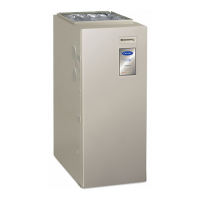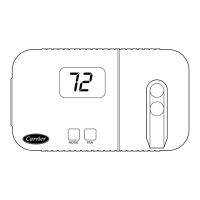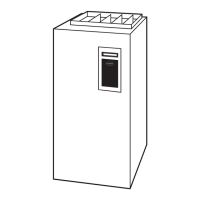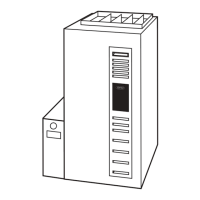Do you have a question about the Carrier 58MVB Series and is the answer not in the manual?
Achieves up to 96.6% AFUE, enhanced by variable-speed design.
Automatically adjusts heating levels for precise temperature control and quiet operation.
Safe, quiet operation with minimal air infiltration for improved indoor air quality.
Actively controls home humidity for enhanced comfort and energy savings.
Durable construction with aluminized steel and polypropylene coating for longevity.
Optimize comfort and efficiency with adjustable motor speed operation.
Lifetime warranty on heat exchangers, 5-year limited on the unit.
Kits for vent termination, concentric termination, and air intake pipe assemblies.
Electronic air cleaners, mechanical air cleaners, and media filters for improved IAQ.
Humidifiers and energy/heat recovery ventilators for enhanced home comfort.
Kits for converting between natural gas and propane fuel types.
Thermostats for single-speed or two-speed air conditioners with auto changeover.
7-Day and 5-2 Day programmable thermostats for advanced comfort control.
Systems for multi-zone temperature control using kits like Comfort Zone II.
Electronic or mechanical air cleaners for removing smoke, dirt, and pollens.
Adds moisture to winter air for improved comfort and material preservation.
Exhaust stale indoor air, provide fresh outdoor air, minimizing heat loss.
Details on motor HP, amps, RPM, wire size, fuse, transformer, and voltage.
Certified temperature rise ranges and external static pressure for heating/cooling.
Airflow CFM and output capacity (BTUH) for various configurations and modes.
Annual Fuel Utilization Efficiency (AFUE) and input BTUH ratings.
CFM airflow at various static pressures for low and high heat modes.
CFM airflow for different ton capacities and static pressures.
Power consumption (watts) for heating modes at various static pressures.
Power consumption (watts) for cooling modes at various static pressures.
Maximum allowable pipe length for non-direct vent (1-pipe) applications.
Dimensions for direct vent (2-pipe) concentric vent kits.
Diagrams showing condensate trap placement for different installation types.
Detailed measurements (A, D, E) for furnace casing widths and depths.
Specifications for minimum return-air openings for various airflow rates.
Dimensions for subbase construction and plenum opening sizes.
Dimensions for media filter cabinet and shipped filter sizes.
Operating voltage range, maximum unit amps, and wire size requirements.
Information on fuse/breaker ratings, transformer VA, and control power availability.
Diagram showing 115-volt and 24-volt wiring connections for furnace operation.
Schematic for connecting thermostats, condensing units, and single/three phase power.
Maximum allowable pipe length for direct vent systems based on altitude and elbows.
Maximum allowable pipe length for non-direct vent systems based on altitude and elbows.
Guidelines on pipe size, material, and avoiding flame sense lockout.
Rules for calculating equivalent elbows and minimum pipe lengths.
Maximum allowable exposed vent pipe length based on insulation thickness and ambient temperature.
Required clearances for service, downflow, and horizontal installation positions.
Diagram showing typical furnace placement and component connections in a basement upflow setup.
Diagram showing typical furnace placement and component connections in a closet downflow setup.
Diagram illustrating furnace installation and component routing in an attic horizontal setup.
Diagram illustrating furnace installation and component routing in a crawlspace horizontal setup.
Achieves up to 96.6% AFUE, enhanced by variable-speed design.
Automatically adjusts heating levels for precise temperature control and quiet operation.
Safe, quiet operation with minimal air infiltration for improved indoor air quality.
Actively controls home humidity for enhanced comfort and energy savings.
Durable construction with aluminized steel and polypropylene coating for longevity.
Optimize comfort and efficiency with adjustable motor speed operation.
Lifetime warranty on heat exchangers, 5-year limited on the unit.
Kits for vent termination, concentric termination, and air intake pipe assemblies.
Electronic air cleaners, mechanical air cleaners, and media filters for improved IAQ.
Humidifiers and energy/heat recovery ventilators for enhanced home comfort.
Kits for converting between natural gas and propane fuel types.
Thermostats for single-speed or two-speed air conditioners with auto changeover.
7-Day and 5-2 Day programmable thermostats for advanced comfort control.
Systems for multi-zone temperature control using kits like Comfort Zone II.
Electronic or mechanical air cleaners for removing smoke, dirt, and pollens.
Adds moisture to winter air for improved comfort and material preservation.
Exhaust stale indoor air, provide fresh outdoor air, minimizing heat loss.
Details on motor HP, amps, RPM, wire size, fuse, transformer, and voltage.
Certified temperature rise ranges and external static pressure for heating/cooling.
Airflow CFM and output capacity (BTUH) for various configurations and modes.
Annual Fuel Utilization Efficiency (AFUE) and input BTUH ratings.
CFM airflow at various static pressures for low and high heat modes.
CFM airflow for different ton capacities and static pressures.
Power consumption (watts) for heating modes at various static pressures.
Power consumption (watts) for cooling modes at various static pressures.
Maximum allowable pipe length for non-direct vent (1-pipe) applications.
Dimensions for direct vent (2-pipe) concentric vent kits.
Diagrams showing condensate trap placement for different installation types.
Detailed measurements (A, D, E) for furnace casing widths and depths.
Specifications for minimum return-air openings for various airflow rates.
Dimensions for subbase construction and plenum opening sizes.
Dimensions for media filter cabinet and shipped filter sizes.
Operating voltage range, maximum unit amps, and wire size requirements.
Information on fuse/breaker ratings, transformer VA, and control power availability.
Diagram showing 115-volt and 24-volt wiring connections for furnace operation.
Schematic for connecting thermostats, condensing units, and single/three phase power.
Maximum allowable pipe length for direct vent systems based on altitude and elbows.
Maximum allowable pipe length for non-direct vent systems based on altitude and elbows.
Guidelines on pipe size, material, and avoiding flame sense lockout.
Rules for calculating equivalent elbows and minimum pipe lengths.
Maximum allowable exposed vent pipe length based on insulation thickness and ambient temperature.
Required clearances for service, downflow, and horizontal installation positions.
Diagram showing typical furnace placement and component connections in a basement upflow setup.
Diagram showing typical furnace placement and component connections in a closet downflow setup.
Diagram illustrating furnace installation and component routing in an attic horizontal setup.
Diagram illustrating furnace installation and component routing in a crawlspace horizontal setup.
| Blower Motor | Variable-speed |
|---|---|
| Gas Valve | Modulating |
| Ignition System | Hot Surface Ignition |
| Fuel Type | Natural gas |
| Heating Capacity | 40, 000 to 120, 000 BTU/h |
| Warranty | 10-year parts limited warranty upon registration |












